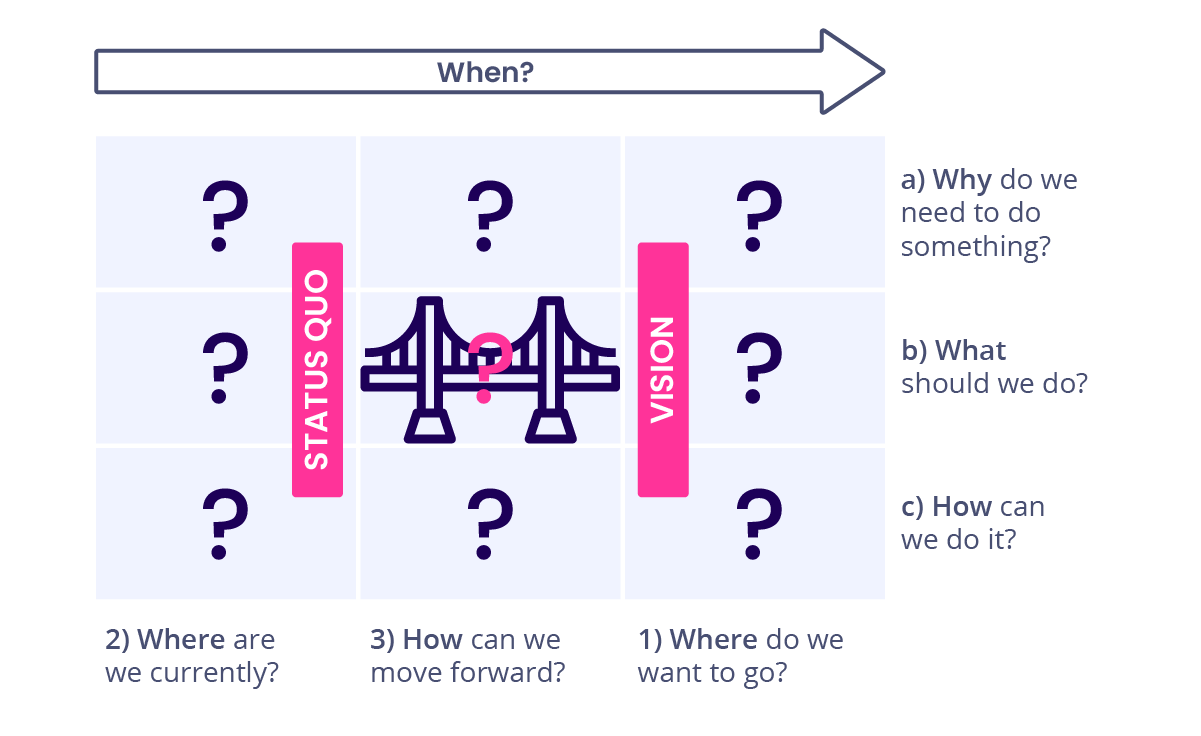A technology roadmap is like a GPS for your tech strategy. Without it, organizations risk getting lost in a maze of disconnected tools, short-term fixes, and unclear priorities. It shows how technology supports business objectives, helping internal teams move in the same direction.
A clear roadmap aligns tech initiatives, allocates resources effectively, and prepares for future developments. This article lists the 10 essential steps every team needs to build a clear, future-ready technology roadmap.

What is a technology roadmap?
A technology roadmap defines how technology investments support broader business priorities. It shows how systems evolve to meet future developments.
It includes key initiatives, expected outcomes, and critical timelines.
Product managers, R&D and engineering teams, and senior management use roadmaps to align goals and drive consistent execution.
Clear roadmaps provide structure while supporting flexibility and continuous updates.
What makes a technology roadmap different from a product roadmap?
A technology roadmap focuses on technical initiatives and how technological advancements fuel new product development. In contrast, product roadmaps provide a higher-level view, oftentimes missing the necessary level of technology development detail.
Technology roadmaps guide engineering teams. Product roadmaps guide product managers, customers, and key stakeholders.
Why technology roadmaps are essential for successful product development
Technology roadmaps give product development teams a strong foundation. They outline what technology alternatives are available and what systems are required to fulfill strategies.
They help allocate resources, avoid delays, and reduce technical debt.
When technology planning aligns with product strategy, teams can innovate faster and with greater confidence.
Roadmaps also provide real-time insights and help teams respond to changing conditions.
Key elements every technology roadmap should include
Technology roadmaps are built in layers. Each layer adds structure—from high-level business objectives to detailed implementation tasks.
The top layer defines strategic goals. Below are key initiatives and timelines.
Deeper layers include current capabilities, responsible teams, and required resources. Each part connects to others.

Activities on a roadmap rarely stand alone. Dependencies between tasks, teams, and systems must be made visible.
Milestones and checkpoints help track progress and manage change across functions.
Clear ownership ensures accountability. Cross-functional teams need to stay aligned throughout the process.
Status updates and room for future technologies keep the roadmap relevant and responsive.
Structured roadmaps help product managers, project leads, and senior management stay on the same page.
Stakeholders and ownership in technology roadmapping
A well-crafted technology roadmap depends on clear ownership. It requires alignment across roles, functions, and business units.
Involving the right people early helps create a comprehensive view of priorities and constraints.
Cross-functional collaboration ensures that technology initiatives support real business needs, not just technical goals.
Stakeholders help identify trade-offs between speed, scope, and resources. This prevents overpromising and underdelivering later on.
Who owns the technology roadmap? Roles of product managers and IT leads
Ownership depends on your structure. Product managers often define what’s needed, while engineering and IT leads decide how to deliver it.
Product management brings internal ideas, customer requirements, and market conditions into the roadmap. Engineering and IT leads focus on system compatibility, capacity, and capability. Together, they create a balanced plan for task delivery.
Clear ownership coupled with smooth collaboration encourages better decision-making and timely execution.
Involving key stakeholders early for better alignment
Bring stakeholders in during the early stages of developing the roadmap. Early involvement helps validate assumptions and surface missing dependencies.
Functional leaders, project managers, and operations teams can flag blockers you might overlook.
This input leads to more realistic timelines and stronger commitment across teams.
The role of senior management in roadmap governance
Senior management drives strategic planning and ensures the roadmap reflects business priorities.
In the end, they sign off the plan, approve major trade-offs, and help balance short-term gains with long-term growth.
They also ensure roadmaps adapt to changing market conditions and technological advancements.
Strong executive support makes the roadmap a living, evolving tool—not just a static document.
Use our RACI matrix template to define the right ownership structure.
Step 1: Define your business objectives
Start your technology roadmap by setting clear strategic objectives. These guide the development process and ensure every initiative supports broader business objectives.
Without a defined strategic direction, teams risk misalignment and wasted effort. Different strategic directions can also serve as layers for the roadmap.
Link each technology initiative to a specific outcome that drives significant progress for the organization.
A strong foundation rooted in business needs turns your technology roadmap into a focused, actionable plan that aligns technology planning with long-term goals.
Step 2: Identify key stakeholders
A successful tech roadmap depends on involving the right stakeholders from the start. Stakeholder input dictates specifically how technology supports business goals, and new product development initiatives, and shapes project planning.
Include product management, representatives from customer and sales teams, IT and engineering leads, project owners, and operations teams as well as senior leadership. Each brings a unique perspective to the roadmap process.
Cross-functional input ensures realistic timelines, identifies dependencies, and improves alignment across teams.
Business leaders help connect roadmap items to strategic priorities. Technical teams assess feasibility and constraints. Customer and product teams bring in the voice of the customer and their specific requirements.
When key voices are involved early, your tech roadmap reflects real needs—not assumptions—and becomes a tool for collaboration, clarity, and long-term success.
Step 3: Assess current technology and capabilities
Start by mapping your existing systems and tech stack to your business needs. This reveals how well current technology solutions support your strategic objectives.

Conduct a technology gap analysis to identify what’s missing. Pinpoint limitations in existing systems and uncover opportunities for improvement.
Compare current tools with different technologies available in the market. This helps you evaluate whether to upgrade, integrate, or replace.
Understanding these gaps is critical to building a realistic tech roadmap.
It ensures new technologies are chosen strategically, not reactively—allowing your organization to drive innovation and move toward long-term goals.
Step 4: Using prioritization frameworks for technology projects
Prioritization frameworks help teams make informed decisions about which initiatives to pursue first. They support strategic planning by aligning tech investment with strategic objectives.
A holistic approach considers impact, criticality, reach, and effort (RICE-framework). This avoids reactive choices and reduces technical debt over time.
Frameworks also create shared understanding across teams, improving communication and alignment during roadmap development.

By focusing on the technology needed to reach business goals, you avoid overloading teams with low-impact projects.
Prioritization strengthens innovation by ensuring resources go to the most valuable initiatives when developing your tech roadmap.
Step 5: Allocate resources effectively
Resource planning is essential when developing technical roadmaps. It ensures that teams can deliver technology solutions on time and within budget.
Start by estimating the effort and skills needed for key initiatives. Break larger goals into individual tasks to clarify requirements.
Match the right people, business strategy, and funding to each phase of development. This prevents delays and supports steady progress.
Well-planned resource allocation keeps your technology roadmap realistic and achievable. The other way around, a clear technical roadmap provides a clear path for optimal resource planning.
It also helps balance workloads, prioritize critical initiatives, and ensure long-term success across multiple technology projects and development cycles.
Step 6: Create a visual technology roadmap
A visual technology roadmap acts as both a shared document and a governing document. It aligns teams and guides strategy execution and project management across the organization.
This visual plan becomes a strategic blueprint for developing and executing technology initiatives. It outlines key milestones, timelines, and priorities.
Technology roadmapping helps teams assign tasks, track progress, and communicate clearly across departments.
A well-designed roadmap is a critical tool for managing complexity across all teams of the organization and staying on course.
It also supports innovation by making long-term goals visible and actionable—ensuring everyone moves in the same direction with purpose and clarity.
Step 7: Set timelines and milestones
Clear timelines and milestones help you govern your roadmap. They provide orientation to teams to track progress, manage expectations, and stay aligned while developing tech initiatives.
Defining realistic timeframes is essential for each phase of work. This keeps momentum steady and avoids delays.
Milestones mark critical decision points, launches, or dependencies that influence other tasks.
As new technologies emerge, timelines may shift—build in flexibility to adapt to technological advancements.
Well-planned schedules ensure your technology roadmap stays relevant and achievable, even as your tech stack evolves.
Timelines provide a forward-looking view that determines strategic planning and continuous improvement.
Step 8: Align your roadmap with project management
Your technology roadmap should connect directly with your project management software. This ensures tech initiative tasks connect directly with business goals and stay on track.
Align it with your product roadmap to coordinate internal systems and customer-facing features. Consistency avoids misalignment and delays.
Use project management software to break down roadmap items into actionable tasks. Select a roadmap software with Microsoft Teams integration to improve visibility and team collaboration.
As new tools and priorities emerge, update both roadmaps together. This creates a seamless workflow.
Strong alignment keeps your technology roadmap grounded in execution, helping teams deliver value faster and more efficiently.
Step 9: Communicate and socialize the roadmap
A technology roadmap only works when everyone understands it. Clear communication is essential during and after developing the roadmap.
Start by sharing the roadmap with all relevant teams. Make it accessible, easy to read, and aligned with business goals. Technology roadmap software is the best choice to ensure easy access and is today a best practice approach.
Use meetings, user interviews, and feedback sessions to gather new input and improve the clarity of your technology roadmap.
Explaining the "why" behind each technology initiative and connecting it with business objectives and market trends builds trust and buy-in.
Socializing the roadmap ensures alignment across departments and reduces confusion.
Consistent updates help teams adapt to changes and stay focused. A visible, well-communicated roadmap drives better execution and collaboration.
Step 10: How to run roadmap review cycles and retrospectives
Regular review cycles keep your technology roadmap relevant and aligned with strategic objectives. They help teams adjust to shifting priorities, new information, or unexpected blockers.
Set review intervals based on project pace—monthly or quarterly works well for most initiatives.
Roadmaps provide structure, but flexibility is key. Use retrospectives to reflect on what worked, what didn’t, and why.
Engage cross-functional teams to share insights and improve future planning.
Reviewing your roadmap ensures that technology efforts stay focused, resources are used wisely, and your initiatives continue to progress toward long-term business success.
Technology roadmap tools and best practices
Using the right tools makes technology roadmap development easier and more collaborative. Choose platforms that offer integrations, visual timelines, and controllable stakeholder access.
What a good technology roadmap template looks like
A strong template includes strategic goals, initiatives, timelines, milestones, and responsible owners.
It should be simple to read but flexible enough to update as priorities shift.
Color-coded phases or swimlanes help visualize different focus areas—such as systems upgrades, integrations, or innovation projects.

Choosing the best software for technology roadmap development
Look for tools that offer customizable views, collaboration features, and easy integrations.
The best software lets you assign tasks, update progress, and connect your roadmap to project workflows.

Prioritize usability—your team should be able to access and update the roadmap with minimal training.
Scalable platforms grow with your needs and help both short- and long-term planning.
Roadmap red flags: when to pivot or reprioritize
If initiatives no longer align with strategic objectives, it’s time to reevaluate.
Other red flags include missed deadlines, overlapping efforts, or lack of engagement from key stakeholders.
Changes in market conditions or new technology may also signal a need to pivot.
Frequent feedback loops help you catch these issues early and course-correct before they become costly.
Build your technology roadmap. Today with the best tool.
Creating and managing roadmaps manually can be complex and time-consuming. By leveraging ITONICS Roadmap Software, organizations can significantly ease the process of creating and managing roadmaps.
Streamline Planning: ITONICS simplifies the creation of roadmaps with customizable templates and drag-and-drop functionality. This makes it easy to map out projects, set milestones, and assign tasks without the need for extensive training.
Improve Collaboration: The software enables seamless collaboration across departments and teams. Real-time updates and shared workspaces ensure that everyone is on the same page, reducing miscommunication and fostering teamwork.
Integrate Data and Insights: By integrating with other systems and incorporating data on trends and technologies, ITONICS helps organizations align their roadmaps with market developments and strategic objectives.










